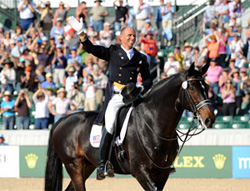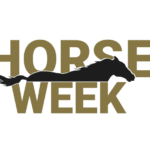April 11, 2010 — Emotions always run high at the American Invitational, the USA’s signature show jumping grand prix, but the 37th edition of the $200,000 class topped them all for tears and joy.

The competition itself was the usual nailbiter, as Jeffery Welles rode Armani to victory in a three-horse jump-off, but what really made yesterday evening so special was the presence of its founder, Gene Mische.
The cancer survivor hovered near death after being hospitalized with a variety of complications last year; in fact, doctors told relatives at one point that it was time to pull the plug. But they would have none of it and flew Gene to the Cleveland Clinic for treatment. His fighting spirit came to the fore and spurred an amazing revival. Four months later, Gene was able to attend the event he founded that changed the face of show jumping in the U.S.
Thinner and leaning on a cane, Gene was still a formidable presence at the class that used to be the Budweiser American Invitational and has been renamed the Gene Mische American Invitational in his honor.
A highlight was the half-time tribute to Gene, saluting him as the impresario who invented the Winter Equestrian Festival (WEF) and made so many other contributions to the sport. He obviously was relishing every moment of the class run under the lights in Raymond James Stadium. At the end of the tribute, fireworks unexpectedly went off in a nearby stadium, which turned out to be an appropriate exclamation point.
The competition nearly had a fairy tale aspect when Gene’s grand-nephew, Michael Morrissey, was faultless until the final fence, where he had a knockdown with Crelido. Can you imagine if he had won? Wow, that would have been a made-for-TV-movie story.
Gene’s nephew and young Michael’s father, event manager Michael Morrissey, labored mightily with many others to make sure there was a 2010 Invitational. A good part of the motivation came from knowing it would give the struggling patient a reason to get better.
The 2009 Invitational had financial problems, and prize money wasn’t paid until months after the competition. In January, a letter went out to Gene’s friends and others in the industry, seeking contributions to make the 2010 edition happen.
One of those who pitched in was Gustavo Mirabal, whose G&C Farm became the class’s presenting sponsor. Gustavo, a Venezuelan lawyer and banker, also has stepped up to back the Nations’ Cup and other competitions at the Palm Beach International Equestrian Center in Wellington next year.
“I’m very passionate about horses and the horse show. When they told me the Invitational needed a little hand, I was pleased (to help), because this is one of the classics and we have to maintain it,” said Gustavo.

He saw the Invitational only once, four years ago, but noted, “I was impressed how beautiful it was.”
Although his farm’s rider, Pablo Barrios, was far out of the ribbons with an uncharacteristic 24 penalties on Blanchee, Gustavo and his family still had big smiles on their faces after standing with the top three riders during the presentation ceremonies.
Gustavo is the guiding light of the Venezuelan team that will compete at the Alltech FEI World Equestrian Games this fall. Don’t be surprised when that squad makes its presence felt there.
The Invitational didn’t fill its quota of 30 rider slots, starting instead with a field of 25. The dynamics of the winter circuit have changed since the days when Gene’s Stadium Jumping Inc. ran both the Wellington and Tampa portions of the WEF. The Invitational once was staged as a sort of thank-you to the best of the WEF riders, and was free of charge as the climax of the lucrative circuit. The Invitational also had a rider drain because four of the country’s top five are competing in Switzerland this week at the Rolex World Cup finals.
The Invitational has a loyal and knowledgeable fan base. Despite lack of advertising due to budgetary constraints, nearly 5,000 people showed up, walking the course before the class and cheering enthusiastically for their favorites.
Gene and manager Michael Morrissey both vowed that the class will happen again next year, pooh-poohing rumors that the 2010 Invitational would be the last. Next year, it is not scheduled to be practically on top of the World Cup finals, which should help, and Gene wants to have a bigger purse, though obviously the basic financial situation has to be addressed first to give the enterprise credibility. I noticed Michael giving Jeffery his check at the after-party, and he told me he was fulfilling the prompt payment promise he had made to the U.S. Equestrian Federation.
U.S. Show Jumping Coach George Morris talked with me about how important it is to keep the Invitational going, especially because the trend is to longer and longer show series at one location, so a “fresh” venue has a nice impact.
The course at the Invitational is always a beautiful showcase. My favorite jump was the 3A-B adobe walls double, complete with “cactus” standards, a western saddle and a lifesize cutout of a sleepy fellow in a sombrero. My second favorite was an effusively decorated triple bar that looked like a lavender wedding cake.
I wondered how the “house” course designer Steve Stephens had come up with his route, considering that the starting line-up was not as much of a powerhouse as it had been in the past. He had some interesting thoughts.
Steve certainly was right that the 9A-B oxer/liverpool combo would mean trouble. President’s Cup winner Todd Minikus suffered two refusals there with Alaska and was eliminated. Seven others had knockdowns at that double, including style award winner Beezie Madden (Mademoiselle) and Steve’s wife, Debbie (Cleu).

Jeffery has always been a top player, but Armani–touted as a hot prospect for the 2008 Olympic team–missed that chance when he was out with an injury for a year. This year’s WEG trials, which ended last month, were a little too early for Armani, but last night he showed the kind of form of which he is capable.
Veteran Mac Cone of Canada, who rode in the first Invitational, blazed the way for the clean rounds with Ole, followed by Jeffery and 1996 Olympic silver medalist Peter Leone, who hadn’t been in the class for more than 10 years. Peter was aboard Select, a newcomer to his string that he has ridden in only four grands prix.
Mac went first in the jump-off, and Ole looked tired, dropping three rails and removing a threat to his next two rivals.
Jeffery didn’t go for broke with only Peter behind him, but he couldn’t run the risk of sacrificing too much speed for a clean round. His time of 44.36 seconds gave Peter something to shoot at with Select, but going a little too wide at the third fence cost him, and he couldn’t quite catch Jeffery, winding up in 44.87 seconds for second place.
I asked Jeffery to explain his thinking for the jump-off.

Having been second in the Invitational on Armani in 2005, finally winning it meant a great deal to Jeffery, and even a whisper that the Invitational might not be held again was disturbing to him.
“I would like to think people are going to rally and try to make this continue in the way that it’s been. Hopefully, that will happen. It would be a real shame to see it not continue,” he said.
“I feel the same way,” added Peter. “It’s part of our sport here in America, thanks to Gene Mische and Stadium Jumping. I hope it’s not the last.”
As Mac observed, “The facility down at Palm Beach (Wellington) is a Godsend, because the championship level of our sport is now going to that kind of a venue. For us to have a facility like that to prepare and get comfortable with is a wonderful thing.

“However, to lose a venue like this when you’re at a place (Wellington) like that for so long–and I think that’s part of the reason that maybe we’re going to lose this is because we’re there too long, and we’re overdoing that place almost to a certain degree,” he said.
Mac cited shows like Spruce Meadows and the Invitational as “special places and that what makes sport, not necessarily staying at the same place banging away for 12 weeks doing the same thing over and over.”
Those who have been in show jumping for awhile “dreamed of coming here…To have this leave our sport, we need to rethink where we’re going,” he emphasized.
So let’s hope the determination of Gene, Michael and others will keep the Invitational going. It’s my 27th time covering the class, and while I have so many great memories of it, I’d like some more. There’s nothing generic about the Invitational; it’s an original…
Be sure to check out my photo gallery capturing more of the key moments of the Invitational on a very special night. Next up for me later this month is a look at the WEG dressage test event, which is running at the same time as Rolex Kentucky. Of course, we’ll focus our coverage April 23-25 on that fabulous 4-star. So. y’all come back now, you hear?
Until then,






